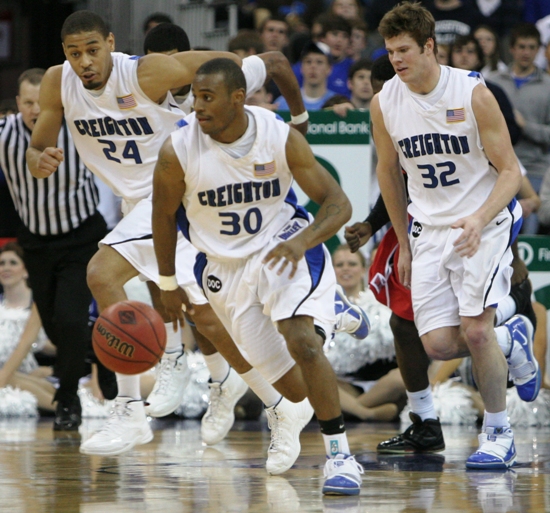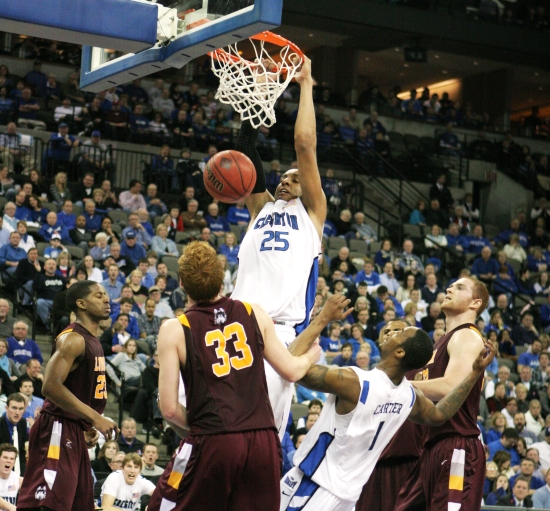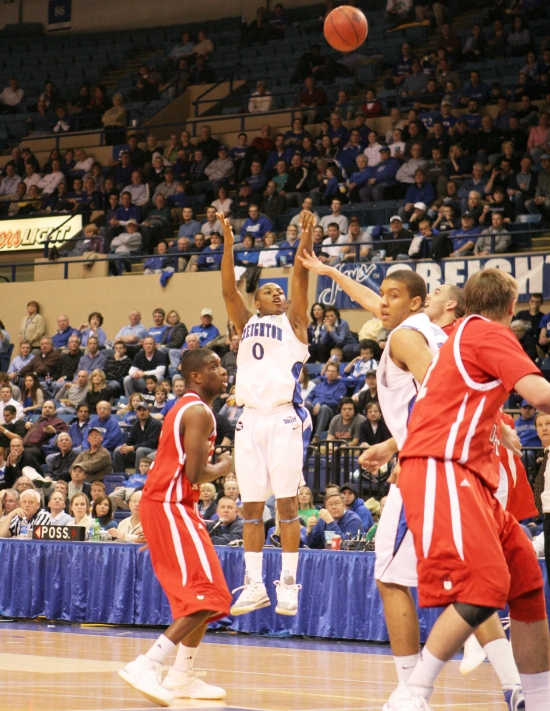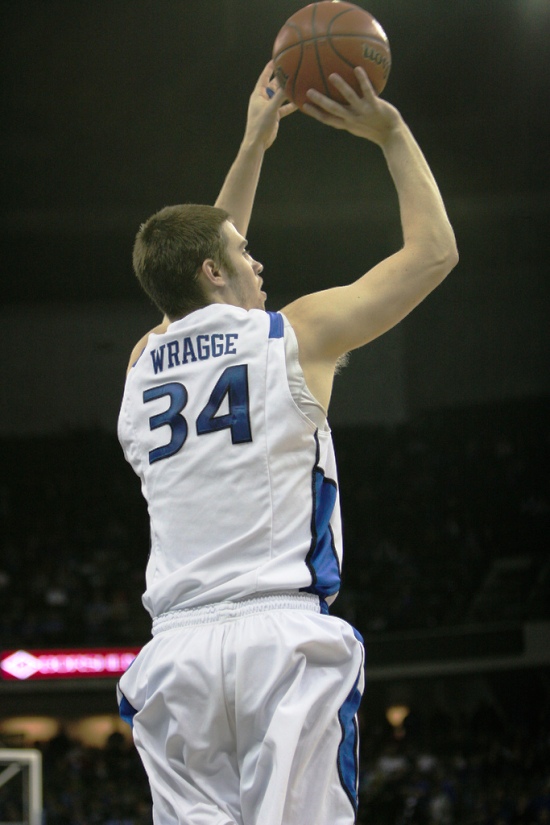A season that for many fans and followers of the program ended around 4:30 p.m. on the first Friday in March came to its official close last night in Springfield. The Bluejays own 16 wins all-time in Springfield but they couldn’t add to that total, losing 67-61 in the semifinal round of the CollegeInsider.com Tournament.
In many respects, the three games the Jays played in this postseason tournament were an accurate reflection on how their season seemed to play out:
- a blowout against an overmatched foe at home (that featured a surprisingly closer-than-predicted final score due to some late makes and some CU lapses on defense);
- a closer home win against a fairly decent opponent (that featured a surprisingly larger-than-predicted final margin due to the Jays hitting free throws down the stretch and playing some good defense); and
- a loss against a team the Bluejays beat at home but couldn’t get over the hump against on the road (supported by lackluster shooting overall, inability to get key stops on defense, and poor results from the bench).
Max and Patrick recapped CU’s previous two efforts in the CIT, games during which the biggest attraction seemed to be the return to the Civic Auditorium. But there were some outstanding individual efforts by Creighton players during these three extra games, efforts and stat lines Jays fans can only hope the players and coaches responsible for can use as a stepping stone to improving next season’s fortunes. I went to both home games but didn’t have a chance to listen to the semifinal loss to the Bears, and I tend to disagree with CU backers who weren’t pleased with Creighton’s participation in this event. Any player worth his scholarship, and any coach worth their pay and their position, would love to keep playing basketball. If you love the game, why would you not want to continue playing? Maybe that’s naïve (coming from a 5-foot-7 “combo” guard who last played a meaningful basketball game as part of a high school intramural team dubbed “Fat n’ Nasty,” that’s highly likely), but for the sake of the Creighton hoops program I would hope it is an accurate assessment of the opportunity to play more games.
ANYWAY, some good things came from Creighton’s CIT games, if not a shiny new trophy for the Vinardi Center. What might they be, you ask?
—
Antoine Young continued to pave the way for making this his team. Face it; Dana Altman hasn’t had a faster point guard in the program for a decade, if ever. But like a fine sports car (again, not something I have much experience with, other than watching commercials featuring said cars), speed and quickness doesn’t mean much if you can’t handle it. And in Young’s case, that means handling the basketball, handling Altman’s offensive sets, and handling some of the scoring duties.
Because this team failed to feature a go-to perimeter scorer, something previous CU teams relied on almost exclusively to put points on the board in previous years (Booker Woodfox; Nate Funk; Kyle Korver; Ben Walker and Ryan Sears; Rodzilla), Young had to evolve into almost a score-first point guard. After scoring in double figures in just 3 of his first 26 games (5.5 points per game), Young scored 10 or more points in 5 of his last 8 games (12.1 ppg). This stretch included his two best scoring efforts in his brief Creighton career: taking over the road win at Southern Illinois with 22 points, and adding 17 in last night’s loss at MSU.

Young leads the Bluejays into the future
As the focus turned away from getting P’Allen Stinnett shots to asking Antoine to do more offensively, the other parts of Young’s game improved too. In those first 26 games, Young averaged 2.8 assists and 1.34 turnovers. In his last 8 games, the sophomore averaged 4 assists and less than 1 (0.88) turnover per contest. He even posted his two career-best rebounding efforts against Bradley on Senior Day and Missouri State last night (5 boards in each game).
But for all the advantages his speed and quickness and basketball savvy afford him, Young was unable to cash in on the defensive end of the ball. He is perhaps Creighton’s best on-ball defender, yet he failed to record a steal in CU’s final four games of the season. He averages half a steal per game for his career. In comparison, Josh Dotzler (1.7 spg), Tyler McKinney (1.1 spg), and Ryan Sears (2.3) more than doubled that average over the course of their careers. By all accounts Antoine is a hard worker, and you can bet he’ll spend court time working on his defensive intensity and anticipation. If he adds ballhawking to his expanding offensive repertoire, his upperclassmen years at Creighton could be among the best point guard play CU fans have seen in awhile.
Kenny Lawson set the stage for a sensational senior season. Lawson has been in Omaha for four seasons, having redshirted his freshman year. During that time, the big man from California has been the clear example of hard work and dedication leading to improved results. Altman always goes out of his way to compliment Kenny’s ability and his drive to get better, including wishing out loud, via the media, more players in the Creighton hoops program would emulate Lawson’s devotion to his craft. In a game where statistics can mean everything and nothing at once, Lawson’s numbers are remarkable if not for their sheer trajectory.
- Start with his baseline season in 2007-2008, when seemingly everyone picking up minutes was a fresh face. He played 15 minutes a game and scored 6 points per contest. He grabbed about 4 boards and blocked almost 1 shot each game.
- As a sophomore, he increases his scoring (8.5 ppg), rebounding (4.8 rpg), and blocks (1.6 bpg) while playing just 4 more minutes per game, on average. He splits time in the post with Kenton Walker.
- Junior season found Lawson establishing himself as Creighton’s go-to player. He once again improved his scoring (13.1 ppg) and rebounding (6.7 rpg) while increasing his minutes (24.1 mpg). He added a 3-point shot to his game, albeit not until mid-February, and shot 8-13 from long range.
Like Young, Lawson’s last month of the season saw the further evolution of his game. In addition to the installation of his 3-point shooting, during the last 7 games of the season Lawson averaged 8.3 rebounds per game (an improvement over his 6.4 rpg average for the first 27 games of the year). During that same time, he improved his scoring average to 15.4 ppg from 12.5 ppg (it would have been a bigger increase, if not for a 2-point effort against South Dakota).

Lawson proved to be one of the Valley's best in 2009-2010
Lawson has had physical setbacks during his years at Creighton, adding further context to his hard work to improve. His track record indicates more improvements are on the horizon for his senior season, which will further establish Lawson as the Bluejays’ most indispensible player.
A comfortable and consistent Josh Jones could be the next star guard at CU. “Me, I like to hoop, so whenever and wherever, I’m ready.” That’s my favorite quote from the entire 2009-2010 Creighton men’s basketball season. It came from Jones, whose season didn’t really start until Stinnett’s ended. Jones, a basketball junkie who always looks like he’s having fun on the court, went from virtually no playing time to playing 10 minutes a game to being a starter and averaging 18 minutes per contest during the last two months of the season. In one of Steve Pivovar’s stories before the CIT started, Jones addressed his interest in participating in the tournament. And it pretty much cemented my opinion of Jones as a player.
He might be a streaky shooter. And he might have a lot to learn about defense. But Jones wants to be on the court so bad, you as a fan want to see him out there as much as possible.

Jones took advantage of his increase in minutes
He averaged 6.4 ppg beginning with the road win at Bradley the last week of January. And you practice shooting and driving all by yourself. But it would seem to be difficult to practice defense on your own; guarding your own shadow probably doesn’t work to well. So, the guy needs seasoning on the defensive end. You get that in practice, and you get that in games. And guys like Jones, the ones who “like to hoop,” probably tend to defend better in games than in practice. Again, that’s probably naïve and speculative, but it sure seemed to me that Jones gradually improved defensively during the last two months of the season.
He capped those improvements with 5 steals in the CIT (3 against Fairfield, 2 against Missouri State); comparatively, he had 4 steals total from January 27 through the CIT game against South Dakota. Again, it would be speculative to insinuate that Jones magically learned how to be a lock-down defender during the extra practices provided by Creighton’s participation in the CIT. But, it is probably safe to say that Jones benefited by the extra organized court time and game experience. If he can extend those experiences into the offseason and build on what was a fairly impressive finish to his redshirt freshman year, Jones could be poised to become the next star perimeter scoring threat for the Bluejays.
Ethan Wragge has a chance to embrace the comparisons to Kyle Korver and exceed expectations, or buckle under the weight of those resemblances. Statistically, Wragge is as accurate a shooter his freshman season as Korver was during the 1999-2000 season. While Kyle attempted more 2-point field goals his freshman season and had a better overall field goal percentage (47.5% to 44.1%) than Wragge, the two share almost identical 43% 3-point shooting percentages from their freshman seasons. Korver holds the all-time Creighton record for made 3-pointers in a career, but Wragge hit more triples (68) this year than Korver did as a frosh (63). And according to Statsheet.com’s formulas, both 6-foot-7 forwards posted True Shooting Percentages of 65.5% their first seasons at CU.
But favorable comparisons of Wragge to Korver end outside the 3-point arc. Korver posted better freshman season averages than Wragge in rebounds (3.1 vs. 2.3 rpg), assists (1.0 vs. 0.44 apg), and steals (0.6 vs. 0.24 spg). Plus, the bar is set extremely high relative to Korver’s improvement from his freshman to sophomore seasons. He nearly doubled his scoring (8.8 to 14.6 ppg), rebounding (3.1 to 5.8 rpg), assists (1.0 to 2.0 apg), and steals (0.6 to 1.8 spg) from his first to second seasons. Altman often uses this metamorphosis as one of his main examples of what hard work and dedication, coupled with talent and ability, can yield for a player who puts in the time and effort to improve.

Wragge proved he can shoot; can he improve the other areas of his game too?
Can Wragge seize the opportunity that exists in the combination of Altman’s offensive system (which caters to wing players who can shoot from outside), his insertion into the starting lineup, and his natural abilities? He already shoots better than most players in the Valley; if he becomes more than an outside shooter, there is no reason he can’t mold himself into an all-Valley wing player.
—
Past experience seems to indicate there will be changes afoot in the hallowed halls of the Vinardi Center. In a little less than 7 months, the 2010-2011 Creighton Bluejays will officially begin practices. No one knows what the roster will look like, and how injuries and other setbacks might shape the state of the program. But for a season that saw impressive streaks end or continue in dubious fashion, not all was lost. Young, Lawson, Jones, and Wragge were bright spots for this year’s team, and the form the foundation of what next season holds for CU hoops. Here’s to a healthy offseason, filled with focus, effort, attention to detail and defense, and a dedication to returning Creighton to the top of the Missouri Valley Conference.
